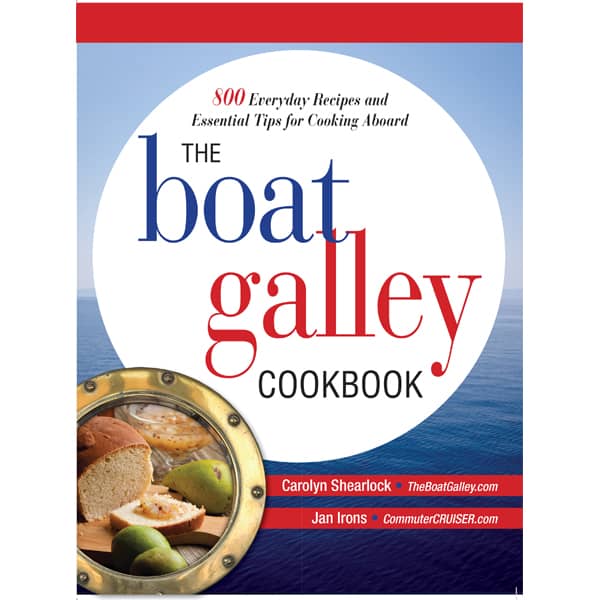There we were, our first night out of the marina with our new-to-us boat. I’d planned a special dinner, including a rice salad. Little did I know that we’d picked one of the rolly-est anchorages we’d be in any time over the next six years. But I did quickly learn the value of pot restraints!
Actually, when I had initially explored what the previous owners had left in the galley, I’d come across these funny little metal arms with screws on one end. It had finally dawned on me that they fit on the stove to hold pans in place. On previous charters, I’d used the stove gimbal, but never pot restraints.
That first night at anchor on Que Tal, as I put the pan of rice on the burner and watched it slide across to the other burner, it hit me that I’d better dig those pot restraints out . . . quickly! From then on, I never took them off until the day we “prettied up” the boat in preparation for selling her.

In the photo, you can see the pot restraint holding the tea kettle in place. I haven’t yet put one around the pot with the clams — but I’m about to!
Virtually any stove designed for use in a boat comes (originally) with pot restraints, also known as pot holders, pan holders or pot/pan clamps. These are the first half of the equation for keeping your cooking on the stove and not on the floor or worse – spilling hot food on the cook (the other half — the stove gimbals — I talk about in a separate article).
Pot restraints are generally metal bars that screw into each side of the stove and “hug” a pan on a burner. You loosen the knob a little to swing the bars into the correct position, then tighten the knob back down so that the pot doesn’t slide with the motion of the boat. Other brands have different mechanisms, but these are the most common. These aren’t just for use underway – they’re also great in rolly anchorages or those with lots of passing traffic. And I’ve even needed them in marinas a few times when there was a good norther blowing and we were heeled right at the dock!
Unless you spend almost all your time at a very sheltered marina, I highly recommend leaving your pot restraints in place and using them all the time if you have a monohull – if you always use them, you won’t forget when conditions are marginal. And you never know when a fishing boat or JetSki is going to go roaring past you, even in a glassy calm anchorage.
Even though we now live on a catamaran, I still use my pot restraints periodically, both underway and in rolly anchorages.
I generally refrain from saying that you “need” a particular item, but these are an exception. They are truly a safety item. Without them, every pan on the stove is a potential major burn on the cook if it slides while hot. Boiling water or hot oil can be spilled right down the front of anyone in the galley.
Unfortunately, pot restraints can be hard to find and expensive ($40 or more) if the ones that originally came with the stove have been lost. However, the cost is slight compared to the pain and healing time — not to mention the doctor bills literally being more expensive — of spilling a pot of boiling pasta or chili down your legs.
The best place for finding them is boater swap meets, boating consignment shops and places that pull parts from wrecked and abandoned boats. Depending on the brand, you may also find new ones by Googling “[brand] pot holder” or “boat pot holder” – just “pot holder” or “pot restraint” gets too many of the wrong thing. You could also check with the manufacturer of your stove.
NOTE: The restraints that came with my stove were always fine for the cruising we did. However, I’ve heard reports of pans flying out of the typical types of restraints when a boat hard on the wind “fell off a wave” – not so much a rolling action, but a sudden drop and stop – or when the back of the stove, swinging on its gimbals, hit the side of the boat hard. If you expect to encounter such conditions (and think you’d be trying to cook in them), you may want to engineer more sturdy pot restraints specific to your boat.
Additionally, if conditions are rough, it pays to use deep pans that are filled less than half full so that food can’t slosh out. At such times, I use my pressure cooker without putting the pressure weights on, simply because I can lock the lid and have even more protection against spills and burns. Even if the pan falls to the floor, the hot food inside doesn’t spill — although you still have a hot pan rolling around that you need to corral!
If you’ve never been in a rolly anchorage or on a passage where it’s blowing over 10, you may never have seen a need for pot restraints. But just like having non-skid on all your plates and putting drinks in drink holders, pot restraints are a necessity when cruising.

Carolyn Shearlock has lived aboard full-time for 17 years, splitting her time between a Tayana 37 monohull and a Gemini 105 catamaran. She’s cruised over 14,000 miles, from Pacific Mexico and Central America to Florida and the Bahamas, gaining firsthand experience with the joys and challenges of life on the water.
Through The Boat Galley, Carolyn has helped thousands of people explore, prepare for, and enjoy life afloat. She shares her expertise as an instructor at Cruisers University, in leading boating publications, and through her bestselling book, The Boat Galley Cookbook. She is passionate about helping others embark on their liveaboard journey—making life on the water simpler, safer, and more enjoyable.
Simplify meal prep on board with proven strategies for provisioning, maximizing fridge space, and cooking delicious meals aboard your boat.










Bill Robinson says
Love your site,so much very usefull stuff,thank you.Bill.
Abhijeet Oundhakar says
If conditions are rough, wouldn’t you avoid cooking in the first place?
Carolyn Shearlock says
Lots of time it’s not too rough to cook, but you don’t want pans moving on the stove which can happen with very little movement.
John Andrews says
Yes, I’d add the thought that it’s like they say on the airlines: “Please keep your seatbelt fastened at all times, in case of unexpected turbulence”. If a rogue wave pays a visit, sailors would have plenty enough to worry about without hot dinner taking flight, never mind if someone was not clear of the line of fire.
Charlotte says
Great article. Can you tell me which is the new style Force 10 stove versus the old one? Ours is a three burner gas stove, about 6 years old, non gimbaled. Thanks!
Carolyn Shearlock says
I’m betting yours is the new style . . . mine was the new style, and it was new in about 1990 (exact date unknown).
Sue Norris says
I wrote in my journal on our first night cruising that we needed pot holders. 8 years later I am still waiting. Skipper doesn’t do much cooking or we would have had them by now. I just make 1 pot meals if at sea or reheat meals. Pressure cooker and Dreampot (thermos cooker) help.
Love your website.
Gina Smith says
You can also order them from defender.com
The Boat Galley says
Where/how did you find them on Defender? I’ve looked several times and never any!
Mary E Dixon says
On defender.com go to stove & oven accessories. They have several.
The Boat Galley says
Well, duh! How’d I miss that? https://defender.com/en_us/oven-parts-accessories
Colin Mombourquette says
Great information, thank you
Cindy Miller says
I have a gas GE stove, converted to propane, any idea which brand would work best.
Carolyn Shearlock says
A GE stove? Like one made for a house? I doubt that you’ll find any pot restraints that will fit. Most likely, you’ll have to have something fabricated to build a “fence” around the stovetop, then hang pot restraints on that . . . and they may need to be altered to fit the larger size of a home stove, too.
Julia says
I’m curious if you are using pot restraints since you are now on a catamaran?
Carolyn Shearlock says
Yes, particularly underway. But we’ve gotten some nasty wakes in anchorages and it just makes sense to secure the pots.
Jo-Anne Mason says
They are very handy, use them without even thinking about it as a matter of course. I did lose one screw need to get one of those.
Pamela Douglas Webster says
Thanks for the reminder to set mine up before I need them. Generally I’ve been able to change my meal plans based on conditions. Although I did find myself holding a pot while underway when I should have used the pot restraints.
Of course, the worst time to set them up is when you actually need them. 🙂
Lupari Sue says
Waited 11 years for pot restraint. Didnt happen until skipper did 3 month passage without this crew member and he was chief cook. Hhhmmmm.
Greg Norris says
🙂
The Boat Galley says
That’s how the sink I hated on our previous boat got changed . . . I was sick and he washed the dishes . . .
Roma Shaughnessy says
Mine are set up on the stove all the time. Simpler and safer to have them already on than having to dig them out when conditions get rough. 🙂
Judy Sawyer, S/V Honu says
As for coffee prep, we use an REI THERMOS, stainless lined French press. The bottom has a rubber like material so it stays out on the counter. My only complaint was the cleanup. It’s messy discarding the grounds. Found a solution and it’s fabulous. We found these Caffi filters on Amazon. They are made in Denmark, pack of 25, a bit pricey but for us worth every penny. For cleanup, simply dispose of the filter which is on a neat disk form, no mess, no loose grounds.
BoBo Bailey says
Fids
The Boat Galley says
These are different from fids just on the edge of the stove 🙂
Ann Heinrich says
Use these all the time!
lary schmidt says
Ann
if you are related to Dieter Heinrick who transported a 10mm from Annapolis Md. to Buffalo NY
would you please have him contact me. I am in need or advice on how to prepare my 105m
for transport (PCI couldn’t supply much information)
[email protected]
Jill says
Do you know if these can be installed on an electric smoothtop?
Carolyn Shearlock says
It would probably have to custom-designed, but would certainly be do-able.
Laura Lohse says
I am wondering if anyone knows if this can be used on a stove in a home. I am asking for a young lady that has use of only one arm. She likes to cook but the pots move around when she tries to stir the ingredients.
Carolyn Shearlock says
It would take a bit of metal work or welding to make an attachment point (they’re always unique to the particular stove model and home stoves don’t come with the attachments), but it would be totally do-able. Great to you for thinking of it!